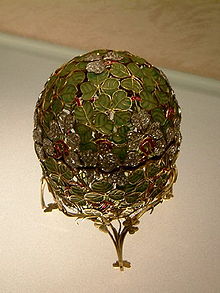- Clover Leaf (Fabergé egg)
-
Clover Leaf Fabergé egg 
Clover Leaf EggYear delivered 1902 Customer Alexandra Fyodorovna Current owner Individual or institution Kremlin Armoury, Moscow Design and materials Workmaster Michael Perkhin Materials used gold, platinum, ruby, diamonds Height 9.8 centimetres (3.9 in) Surprise unknown The Clover Leaf Egg is a jewelled Easter egg made under the supervision of the Russian jeweller Peter Carl Fabergé in 1902 for Tsar Nicholas II of Russia. It was presented by Nicolas II as an Easter gift to his wife, the Czarina Alexandra Fyodorovna. It is currently held in the Kremlin Armoury Museum in Moscow, and it is one of the few Fabergé eggs that have never left Russia.
Contents
Design
The Clover Leaf Egg is made of an openwork pattern of stems and leaves of clover forming the shape of an egg. The gaps between the metal outline of the leaves are covered with transparent bright green enamel. A very thin golden ribbon paved with rubies curls through the foliage. At the time, the production of transparant enamel was still a new method, and often suffered from problems while cooling. There are no flaws in the enamel of the Clover Leaf Egg, but it is considered too fragile to travel.
Surprise
The surprise in the egg has been lost but according to archives but it is reported to be a four leaf clover with twenty three diamonds, and four miniature portraits of the four daughters of the Tsar: Olga, Tatiana, Maria, and Anastasia
See also
References
- Faber, Toby. Faberge's Eggs: The Extraordinary Story of the Masterpieces That Outlived an Empire. Random House (2008) ISBN 140006550X
- Forbes, Christopher and Johann Georg Prinz von Hohenzollern. FABERGE; The Imperial Eggs. Prestel (1990). AISN B000YA9GOM
- Lowes, Will. Fabergé Eggs: A Retrospective Encyclopedia. Scarecrow Press (2001) ISBN 0810839466
- Snowman, A Kenneth. Carl Faberge: Goldsmith to the Imperial Court of Russia. Gramercy (1988) ISBN 0517405024
External link
Coordinates: 55°44′58.25″N 37°36′47.90″E / 55.7495139°N 37.613306°E
Categories:- Fabergé eggs
- Visitor attractions in Moscow
- 1902 works
Wikimedia Foundation. 2010.
